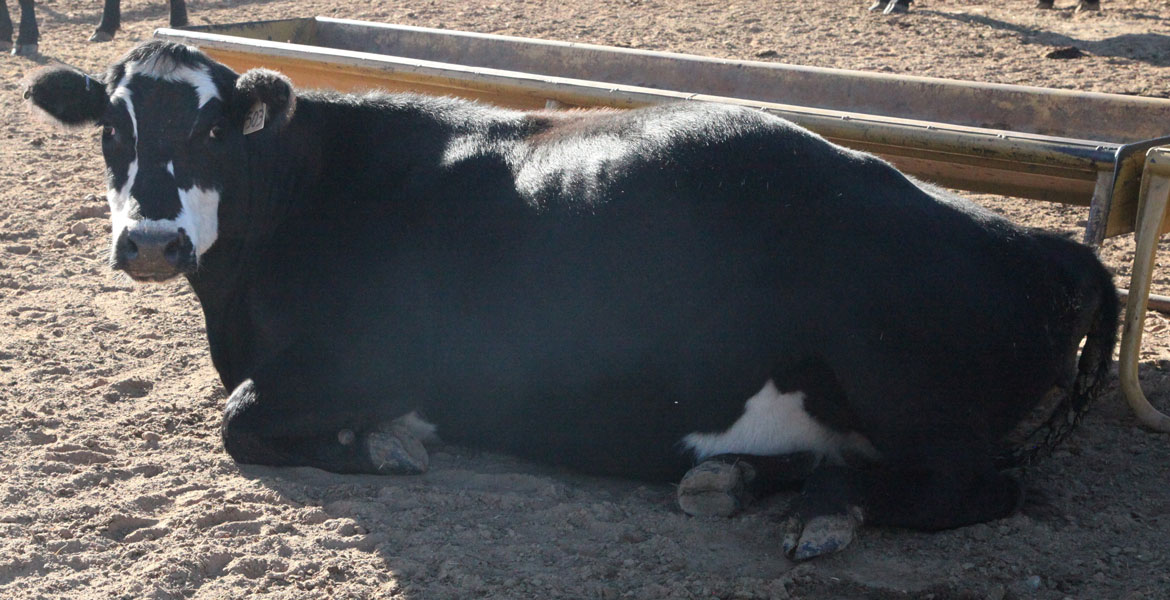
When Cattle Can’t Stand
Tuesday, November 26, 2019
In nature, cattle and other grazing species exist at the bottom of the food chain. From a survival standpoint, they are wired to try to appear healthy and fit until they simply cannot fake it anymore. As a prey species, if cattle appear weak, they become a target for predators. For this reason, owners must be alert to even the most minor signs of illness to initiate treatment early to increase the chance of success.
With this in mind, we know that very severe illness or injury must be present for an animal to be unwilling or unable to stand. Therefore, anytime an animal is unable to rise, it is critically important to correctly diagnosis the problem as soon as they are found and initiate proper treatment.
Most of the causes of cattle not being able to stand fall into what veterinarians refer to as the “5 M’s of Down Cows.” These are categories of disease which help us to develop a list of possible causes and work through each one to determine the cause for each given case. The five m’s are: mastitis, metritis, metabolic, musculoskeletal and mystery. Yes, you read that last one correctly!
Mastitis is an infection of the udder that, with certain bacteria present, can release toxins into the bloodstream causing a cow to become so ill that she cannot stand. This generally occurs very soon after calving. These infections are severe enough that antibiotics alone are not sufficient to effect a cure.
Metritis is an infection of the uterus that, like mastitis, can have certain bacteria present that release toxins into the bloodstream causing severe illness. Also like mastitis, this typically occurs very soon after calving and requires more therapy than antibiotics alone.
Metabolic diseases include several conditions where the metabolic processes of the animal become so disturbed that their nervous system and muscles lack the function to enable them to stand. These can include low magnesium (grass or winter tetany), low potassium, low phosphorus, and protein-energy malnutrition. As we move into the winter season, when dormant forage has lower nutritional value and poor digestibility, we often see cattle with protein and energy deficiencies. This condition is particularly prevalent in heifers in spring calving herds because they have the additional demands of still growing themselves and growing a late-term calf. It is critical that sufficient planning goes into winter feeding to maintain the energy and protein needs of all cattle through the harsh months.
Musculoskeletal diseases include conditions of the musculoskeletal or nervous systems which impair the ability to stand. These could include fractures (usually of the spine or upper limbs), calving paralysis where the nerves in the birth canal become compressed when a large calf is delivered, or any other injury where there is direct damage to nerves or compression by nearby swelling.
And then there’s Mystery. You guessed it: sometimes there are cases where we simply are unable to find a cause. This likely occurs when there is a combination of causes which are not easily defined that culminate in enough inhibition of function of the organ systems that the cow has no choice but to stay down. These cases are the most frustrating to owners and veterinarians alike, particularly when the animal is an “alert downer,” eating and drinking and generally healthy-appearing otherwise.
So, what should you do if you have a down cow (or calf or bull) on your place?
- Immediately roll her up onto her chest so she is sitting up. Use hay bales or a vehicle to prop her up so that she is stable. Lying flat on her side can cause her to bloat, which can be rapidly fatal. It also causes muscle and nerve damage to the legs on the down side, which reduces the chances of recovery.
- Call your veterinarian. With each day that a cow is down, the chances of her getting back up are significantly reduced. Proper diagnosis and early treatment are the most reliable predictors of success. On the other hand, if her illness or injury is irreversible, it is important to determine that early in order to be able to end her suffering. Letting her lay simply to see what happens rarely ends well and often results in a worsening condition in the interim.
- If she must be moved to another location, she should never be dragged by a limb or the head/neck, which can cause severe additional injury. Rather, fashion a sled out of a sheet of plywood or metal and roll the cow onto that and then pull the sled behind a vehicle.
- Make sure fresh feed and water are available and accessible at all times. Place feed and water pans that are shallow enough to allow easy access close to the cow’s head throughout her treatment and recovery.
- Roll her side to side a few times per day so that she is not always laying on the same hind limb. This will help maintain circulation to the limbs and reduce muscle crush injury.
A down animal is probably the single most frustrating condition for which a ranch owner seeks a veterinarian’s advice. The size of cattle makes them difficult to manage and treat and, by remaining down, their weight causes further damage to muscles and nerves. For this reason, we have a responsibility as their stewards to quickly identify the problem, handle them properly, and determine the most humane course of action in their management.
By: Meredyth Jones, Oklahoma State University College of Veterinary Medicine
MEDIA CONTACT: Taylor Bacon | Public Relations and Marketing Coordinator | 405-744-6728 | taylor.bacon@okstate.edu
